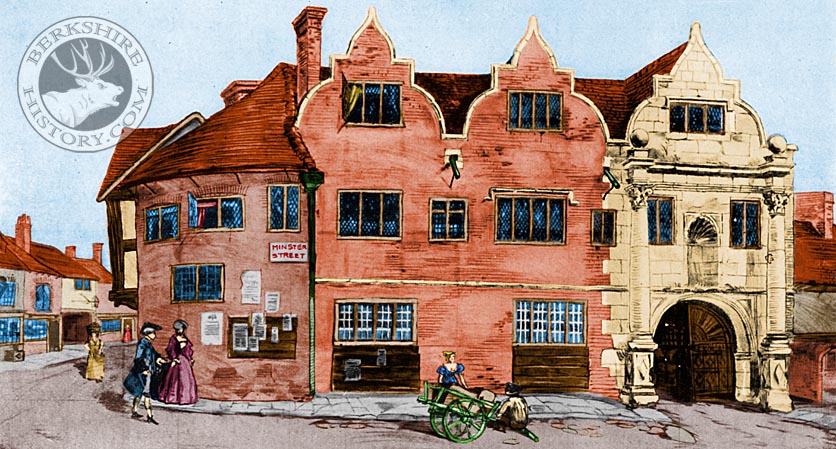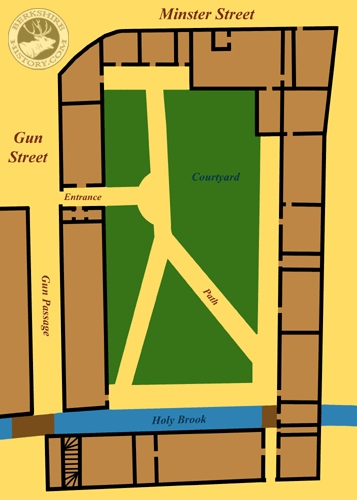 |
 |
|||
|
|
The Oracle, Reading On the penultimate day of 1624, John Kendrick, a rich London wool merchant died. Amongst the many charitable bequests in his will, he left £7,500 in trust to the Mayor and Burgesses of Reading “to build a strong house of brick fit and commodious for the setting of the poor on work" in the cloth trade. John was born and brought up in Reading and his brother, William, still ran the family’s original cloth making business in Minster Street. He was aware of the lack of prospects for many of the poor people of his native town since the dissolution of the great abbey there had removed most of the available poor relief, and John had a vision. He wanted his town to set up a ‘work house’ in the proper original sense of the word: A place where the poor could come and learn a trade and secure themselves a future. The idea was for the Corporation to build a a series of workshops where a number of entrepreneurs could set up in business rent free and employ the local poor to make broadcloths and ‘Spanish’ cloths, using capital from the Kendrick bequest, borrowed at very reasonable rates. One of the most influential members of the Corporation, during the period following John Kendrick’s death, was his own brother, William. One might expect that this situation would make the success of the venture a certainty. However, William Kendrick clearly believed that charity began at home. He had received what was quite a sizeable legacy from his brother, but this was only a very small percentage of the fortune he left elsewhere. William may not have been best pleased and saw the workhouse as a way to claw back his lost expectations. William Kendrick may have foreseen the upcoming decline in the woollen industry and decided to get out and buy himself a landed estate instead, like a true gentleman. So, as the Corporation were obliged to purchase land worth £60 a year to fund their new workhouse, in April 1625, William offered to sell them his farm in North Street in Tilehurst. He furthermore offered them his family home and business in Minster Street for use as the basis of his brother’s new foundation: What could be more appropriate? They also purchased, from Anthony Blagrave, the adjoining plot of open land to the south which Kendrick rented for drying his cloth. However, while this all seemed a good deal in principle, in practice William was determined to take complete advantage of the situation. The farm was only really worth £55 a year and the £2,000 William received gave him a handsome profit. Furthermore, he was very happy in his Minster Street house and, despite having sold it, refused to move out. The Corporation chased him many times for a moving date, but he merely tried to stall them by offering a second deal on the purchase of his looms and other equipment in the house. The Corporation agreed, but having learnt from their previous experience, would not pay up until Kendrick had fully vacated the property. When he still refused to budge, they began building work anyway, with William and family still in residence. It was difficult for them to go further because John Kendrick’s business partner and executor, Lawrence Halstead, perhaps knowing William’s attitude towards the scheme, had refused to release the next payment from the deceased’s estate as the Corporation was using William to act on their behalf. So William had secured his position in the favour by agreeing to advance them the money instead. Later, he was also allowed £1,000 from the bequest, to employ, not the poor, but various members of his family. Eventually, however, after three years of negotiations, the Kendrick family did leave Minster Street. So in 1628, the Kendrick house facing onto Minster Street was extended southward to form a large quadrangular building in brick and tile, around a central courtyard. The Holy Brook ran along this inner garden’s southern edge with little wooden bridges across and through the southern range of rooms. The western façade had a series of fashionable Dutch-style gables and an impressive stone gateway looking straight down Gun Street. It had huge arched wooden gates bearing John Kendrick’s initials and the date of the foundation,
below a shelled niche for the founder's statue, all flanked by Corinthian columns. There were further detached workshops with their own gardens further south. The complex became known as the Kendrick Cloth Workhouse, occasionally the Great House, and, later, the Oracle. Five years later, Reading became key to controlling the Bath Road between London and the West during the Civil War and the nominally Royalist town was quickly placed under siege. Trade ceased. Wealthy men became poor and the rents of endowed property that had provided for some, at least , of the destitute, remained unpaid. The Oracle was seized by the King’s forces and used as a barracks for the soldiers. After the Civil War, squatters moved in. The Corporation wished to dispose of the building but, in the end, allowed the destitute to live there instead. The workhouse was finally reinstated properly as a manufacturing centre after the Restoration, when the Corporation were once again able to collect their rents. Samuel Watlington fitted the place out for 20 poor cloth-workers in the early 1690s, but by 1703, the looms had again been removed and the place became derelict. The building was partly restored in 1720, but a scheme to make it a united workhouse for all three parishes of Reading in 1726 came to nothing. By this time, the cloth industry had all but disappeared and alternative trades were found to move into the workshops. A hundred years after its foundation, the Oracle housed poor craftsmen employed in making sailcloth, sacks and rope, light fabrics such as satin and silk, and particularly in the manufacture of pins. Thomas & Deane’s pin factory was apparently thriving in the 1790s, although, in 1802, Charles Coates described how several of the workshops were shut-up with broken looms and other machinery. Soon afterwards it became used as accommodation for the poor, as well as for their employment. Bartletts’ Sack, Sail and Rope Manufactory was prominent there in the 19th century, while part of the building housed a school run by a Mrs. Stokes. Henry Fox-Talbot famously used the Oracle as the subject of one of his early photographs taken in Reading in 1845. Four years later, Christ’s Hospital, who had been named as a secondary beneficiary under John Kendrick’s will, successfully sued the Borough for misuse of their bequest and managed to obtain what was left of the money. The Oracle building was demolished the following year and replaced by small retail shops.. However, sufficient funds did remain in Reading for the founding of the Kendrick Boys’ School (now part of Reading School) and Kendrick Girls’ School (extant). The
'Oracle,' of course, is now remembered in the name of the shopping centre built over the southern portion of the site.
The old gates for many years stood in the Tilehurst Road, but are now on display
in Reading Museum. |
|||
| © Nash Ford Publishing 2017. All Rights Reserved. | ||||






 However, from the start it was almost impossible to make a profit from the scheme. Complaints of misuse of funds led to William Kendrick publishing a balance sheet to account for the use of his brother’s money. From this, it appears that the borrowers were largely using the loans for their own concerns, particularly Kendrick’s nephews, William Gandy and James Winch, who were monopolising the cloth-trade, undercutting poorer clothiers and driving them into bankruptcy. The Privy Council appointed Reading-born
However, from the start it was almost impossible to make a profit from the scheme. Complaints of misuse of funds led to William Kendrick publishing a balance sheet to account for the use of his brother’s money. From this, it appears that the borrowers were largely using the loans for their own concerns, particularly Kendrick’s nephews, William Gandy and James Winch, who were monopolising the cloth-trade, undercutting poorer clothiers and driving them into bankruptcy. The Privy Council appointed Reading-born